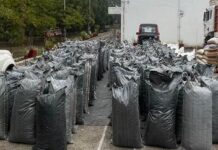Penguins are aquatic, flightless birds that are highly adapted to life in the water. Their distinct tuxedo-like appearance is called countershading, a form of camouflage that helps keep them safe in the water. Penguins do have wing-bones, though they are flipper-like and extremely suited to swimming. Penguins are found almost exclusively in the southern hemisphere, where they catch their food underwater and raise their young on land.

Penguin Facts & Information:
- Penguins are birds that cannot fly. They make up the scientific order Sphenisciformes and the family Spheniscidae. The name “Penguin” comes from the Welsh terms “pen” meaning head and “gwyn” meaning white.
- There are 17 species of penguin, each slightly different. All of the species live in the Southern hemisphere. Many live at the South Pole on Antarctica Some are found on the coasts of South America, the Galapagos Islands, Australia, Africa, and New Zealand. There may be as many as 100 million penguins in the world.
- Penguins have black and white feathers and they waddle when they walk. They also have a torpedo-shaped body. This shape allows them to speed through the water at speeds of 25 miles per hour.
- Penguins spend most of their time in the water searching for food. They cannot swim backwards, however. They are at home in the water as they spin, jump and dive as they play and search for food. A penguin can hold their breath under water for approximately 6 minutes.
- A penguin is a very strong bird and can launch itself 6 feet into the air when leaving the water to return to land. When a penguin wishes to move quickly across the ice, they can be seen falling onto their bellies and using their arms to propel them over the surface.
- Penguins have no biological defenses against germs found outside of the cold Antarctic so they are difficult to keep healthy in zoos.
- Penguins are warm blooded, with a normal body temperature of about 100 degrees F. Just like whales, penguins have a layer of fat under their skin called “blubber”. Overtop of this they are covered with fluffy “down” feathers and overtop of those they have their outer feathers which overlap to seal in warmth.
- Penguins rub oil from a gland onto their feathers to help make them waterproof and windproof. Groups of penguins huddled shoulder to shoulder with their wings tight against their body keeping each other warm. As many as 5,000 penguins will bunch together to warm each other up.
- Penguins eat seafood. Their main diet is fish, though they’ll also eat squid, small shrimplike animals called “krill” and crustaceans. If you look closely at a penguin’s bill you’ll notice a hook at the end, perfect for grabbing dinner. They also have backward facing bristles on their tongues that helps slippery seafood from getting away.
- Penguins don’t live near freshwater — at least none that isn’t frozen. Instead they drink salt water. They have a special gland in their bodies that takes the salt out of the water they drink and pushes it out of grooves in their bill, so the water they are actually drinking is filtered.
- Penguins mate for life. During the mating season penguins head for special nesting areas on the shore. The area where penguins mate, nest and raise their chicks is called a rookery.
- When penguins are ready to mate, the male stands with his back arched and wings stretched. He makes a loud call and struts about to attract a female. When the penguins find a mate, they bond with each other by touching necks and slapping each other on the back with their flippers. They also “sing” to each other so they learn to recognize each other’s voices.
- Penguins will build their nests out of whatever is available even rocks and stones. As soon as the egg is laid (penguins lay one or two eggs at a time), the female dashes out for dinner, leaving the male to watch the nest. When the female returns (it can take up to two weeks for her to come back) it’s the male’s turn to head out for food, leaving the female with the egg.
- When a Penguin chick hatches, it immediately starts calling so that its parents recognize its voice. When the chick is old enough, both parents will leave at the same time. All the chicks in the rookery will stay together until their parents return.
- When the parents come home they again recognize their chick by the sound of its voice. The Emperor penguin is the only species that breeds and nests in Antarctica through the frigid winter.
- Leopard seals are the penguins’ main threat, but sea lions and orca whales are also predators. Some large seabirds like the Australian eagle and the Skua also threaten the penguin. Penguins also have a number of on-land predators like ferrets, cats, snakes, lizards, foxes and rats.
- Penguins can be endangered by oil spills, water pollution, and the over harvesting of the ocean.
- Survival is a major concern for penguins. They make sure that their home lacks predators. It is a must for them to find a place where they will have adequate food and shelter. It is also necessary for them to live in an area where they can reproduce and interact with each other. They settle on a place depending on the climate’s temperature. The water must be at least 10-degrees Celsius, or colder than the temperature of their bodies. There are also penguins that manages to settle in warm temperatures like the Galapagos Penguins.
- Penguins don’t live near freshwater – at least none that isn’t frozen. Instead they drink salt water. They have a special gland in their bodies that takes the salt out of the water they drink and pushes it out of grooves in their bill, so the water they are actually drinking is filtered.
- Penguins spend most of their time in the water searching for food. They cannot swim backwards, however. They are at home in the water as they spin, jump and dive as they play and search for food. A penguin can hold its breath underwater for approximately 6 minutes.
- Penguins eat seafood. Their main diet is fish, though they’ll also eat squid, small shrimplike animals called “krill” and crustaceans. If you look closely at a penguin’s bill you’ll notice a hook at the end, perfect for grabbing dinner. They also have backward facing bristles on their tongues that helps stop slippery seafood from getting away.
- Penguins can eat as much as 1,500,000 metric tons of krill, 115,000 metric tons of fish and 3,500 metric tons of squid in a year.They feed from prey 50-60 feet below the sea’s surface using their bills.
- There are also penguins that travel from 15km to 900km in search of food.
- There are penguins that swallow stones, thus reducing buoyancy when diving and lessening hunger.
- Penguins also practice yearly fasting during the breeding, molting and preparedness for plumage feathers that may last from 54 to 120 days, depending on the species.








